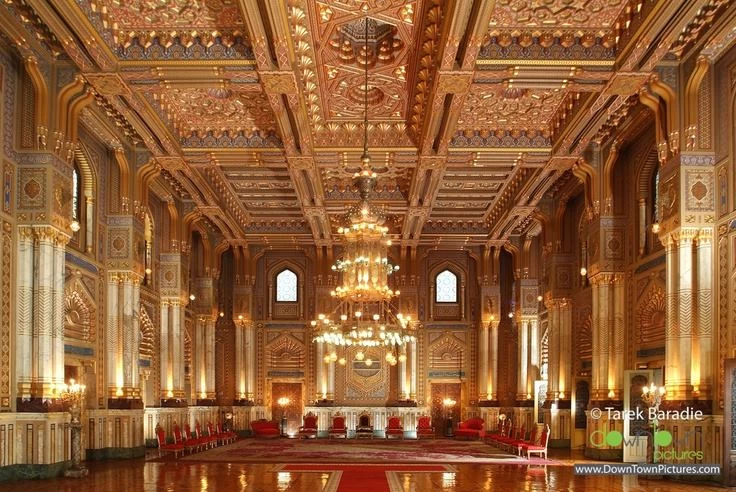


A tour to the Abdeen Palace Museum is an interesting journey through Egypt's royal times, where opulence, culture, and heritage blended into one magnificent monument. From the elaborately patterned halls to the invaluable artifacts on display, the museum provides a focused look into the country's monarchy and its political past. Whether one is a history buff or someone interested in the culturally rich heritage of Egypt, Abdeen Palace Museum is one of those tourist attractions that brings alive the brilliance of Egypt's era of monarchy.
The Abdeen Palace Museum is situated in Heliopolis, in the Cairo city of Egypt. To be more precise, the location of the museum is Abdeen Square, south Soliman Pasha Street. The palace is favorable for travel and tourism in the city because it is located close to major attractions within the city and other historic places like the Egyptian Museum and Tahrir Square.
The Abdeen Palace Museum in Cairo was first built in 1863 by Khedive Ismail as the resplendent royal residence and symbol of Egypt's modernization. Italian architect Rimondo d'Aronco designed the palace with a mix between the European and Ottoman architectural styles, reflecting its opulence and grandeur. Since then, it was the official residence of Egypt's rulers throughout the Khedival period, and until later, it became the presidential palace after the revolution of 1952. In 1984, the place was converted into a museum that retains the Egyptian monarchy's history through its vast collection of royal gifts, artifacts, and military memorabilia.
1. Historical Importance
It was built in 1863 by Khedive Ismail, created as a royal residence that symbolized modernization during the 19th century of Egypt. It used to be an official residence of the rulers in Egypt during the Khedival era and then became the presidential palace of Egypt following the Egyptian Revolution of 1952.
2. Architectural Design
This palace was designed by an Italian architect named Rimondo d'Aronco and could successfully combine the grace of European architectural styles with Ottoman ones. One can see here a great combination of Baroque, Neoclassical, and Islamic motifs showing the lavishness and the cultural influence of Europe at that time.
3. Conversion into Museum
Abdeen Palace was converted into the Abdeen Palace Museum in 1984; it was intended to preserve the history and heritage linked with the monarchy of Egypt.
An exhibition is conducted within the museum, comprising a wide range of artifacts from the royalty, gifts received by them, souvenirs linked to military services, and personal items of the monarchy.
PixaBay
4. Exhibit Highlights
The Royal Reception Rooms are fully decorated with expensive furniture, crystal chandeliers, nicely carpeted, and varnished woodwork, signifying the palace's lavishness in style.
The most emphasized in the palace is the Throne Hall, which is used for official functions and the reception of prominent visitors. Another hall is a museum dedicated to the Royal Gifts, which were given to the Egyptian royal family by overseas heads of state. The Military Museum includes materials connected with Egypt's military history, like uniforms and armament from Egypt's monarchs' era.
5. Location and Size
It is located in the Heliopolis district of Cairo and stands on a square area of 24,000 square meters.
The palace has multiple wings, gardens, and inner courtyards. Every room is a testament to the history and way of life of the royal family.
6. Cultural and Political Function
The Abdeen Palace was not only a residence but also one of the most important sites for major political and ceremonial events.
It entertained many foreign dignitaries and state visitors, another factor that helped it to get established as a hub of influence and power in Egypt.
7. Safeguarding Egyptian Royal Heritage
It contains a display of so many historic documents, photographs, and personal objects of the Egyptian royal family, which allows visitors to peep into Egypt's political and social history during the monarchy era.
The Abdeen Palace Museum maintains and upholds the glory of the Khedival period, thus allowing guests to walk through a residence that once belonged to the rulers of Egypt in an extremely lavish manner.
8. Opening Hours and Visitor Experience
The museum is open to the public, with guided tours given to visitors interested in learning more about Egypt's royal past and the history of the palace.
One of the essential cultural stops in the Cairo Day tour for anyone interested in Egypt's rich history beyond its ancient monuments.
9. Royal Collection
Abdeen Palace Museum proudly contains a large collection: of royal jewels, ceremonial swords, antique furniture, and exquisite artworks.
The visitors can see the Khedive's personal collection of art, as well as the royal archives about the history of Egypt during the time of the monarchy.
10. A Symbol of Egyptian Royalty
The palace is a symbol that stands to speak for Egypt's royalty; it tells about the grandeur of the Khedival era and stands as a witness to the transition of Egypt from a monarchy into a republic.
The Museum of the Palace of Abdeen is a must-go place for any tourist who has an interest in the history of royalty in Egypt, as it provides plenty of insight into the growth of the country over its political, social, and cultural history. Almost all of the people living in Egypt today or coming for a visit acknowledge and appreciate the Empire’s worth and know that the Palace Museum of Abdeen is one of the greatest historical preserved centers in Cairo sightseeing. If you are engaged in the architectural charm or deeply stricken by how many rich monarchs have lived in it, there is something for every visitor with the Best Distition concerning the history of politics and culture in Egypt.

Copyright © 2024 All Rights Reserved
